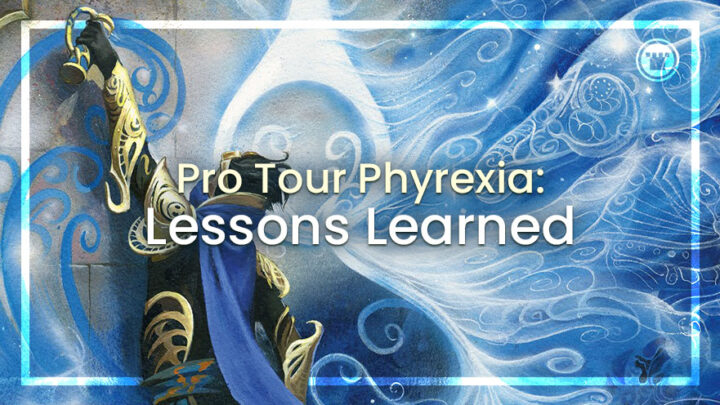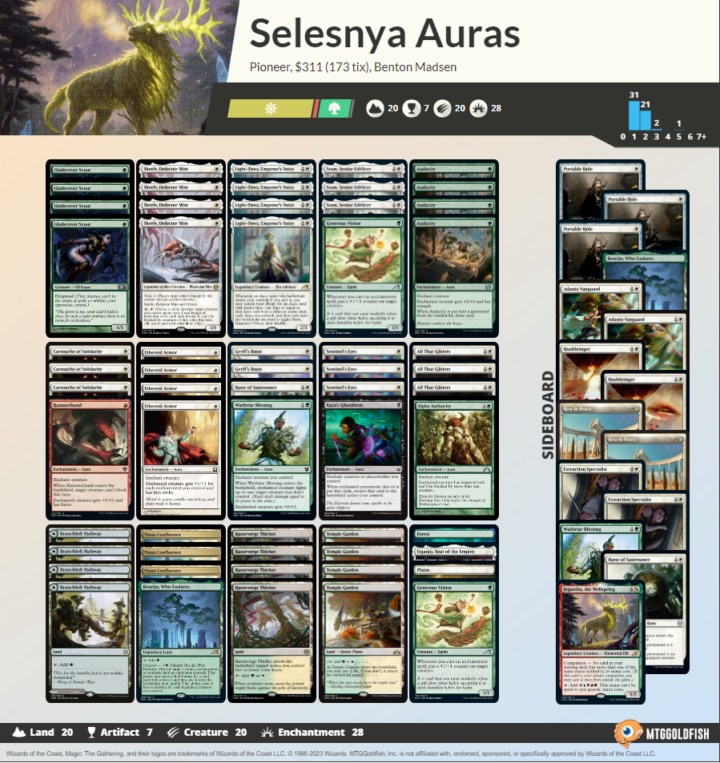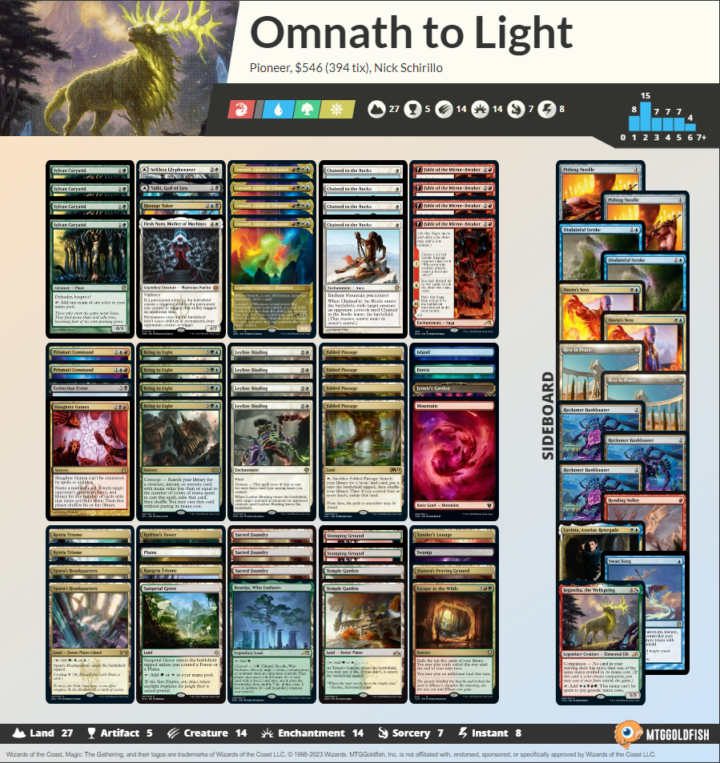The most exciting part of professional Magic returned last weekend with Pro Tour Phyrexia. I’m back from playing in the event myself, and let me tell y’all, the format is NOT where it was just two weeks ago.
There are three breakout decks to examine from last weekend, one of which was piloted by the event’s winner, ChannelFireball’s Reid Duke. Let’s dive into some analysis of these brews while looking into why some of the top meta-players under performed.
Creativity
Duke and most of his teammates showed up with this deck — one that had no new cards despite totally crushing the tournament. But how could what should have been a known entity end up shaking up the metagame so hard?
There are a few key points to keep in mind. First is the deck’s position heading into the event. Metagames eb and flow, so despite Green and Rakdos being format staples, the decks around them have moved a lot.
Lists like Lotus Field rose up and decks like Angels, Gruul and White all got big new additions, increasing their metagame share. That created the perfect storm for this archetype to rise up.
The thing to remember about creativity is your combo can be beaten by a lot of different decks in the format. However, if those decks are not getting played, your main game plan is so strong.
Presenting a 30/30 trampler on turn five is too much for most decks to handle. So, this deck just uses a full stock of interaction to prevent opponents from running over them before it’s time to get one shot.
The second big factor in this deck’s success was the refinement of the list and its sideboard plans. Sometimes, players have a great deck idea without developing a fully functional plan. Then, all it can take to get over the hump and create a true monster is to tinker on the margins.
Team Channelfireball is no stranger to fixing and making functional sideboard plans, as these are some of the best players in the world working to get one deck to full speed. That sort of environment can create diamonds out of coal, and the downward pressure of a Pro Tour can lead to moments where once-discarded decks get tuned to perfection.
Creativity is the best interactive combo deck in the format. If you’re trying to play a normal game of Magic, you’re going to have an incredibly hard time overcoming the amount of pressure this deck provides. Time will tell, though, whether this deck can survive a metagame fully aware of its presence.
Auras
This deck took the Pro Tour by storm. Benton Madsen came in and went undefeated all the way to the finals against Duke. So, why is “Boggles” so powerful all of a sudden?
The biggest get is Razorverge Thicket. The deck always had the potential for fast and powerful starts, but the mana didn’t support it. Razorverge fixes that, for the most part, allowing you to actually cast a turn one Gladecover Scout into a turn two Light-Paws.
Before, your deck fell apart too easily due to its mana and forced you to lean really hard on white. However, that’s not the only big addition this deck got.
We highlighted Skrelv a lot in our articles leading up to the release of Phyrexia: All Will Be One. This card is not Mother of Runes by any means, but it does provide great protection for a deck leaning heavily on a few cards in order to win.
While not a fool proof plan, it does tax opposing removal a lot more and can make decks like Mono White, which are leaning on a singular answer (like Brutal Cathar), unable to actually answer the suited up creature.
These decks are always meta calls. They are fundamentally flawed and force you to mulligan a lot. Since your draws can produce such different results, it can be hard to call it a consistent deck. But when the time is right, something like Auras is often the best deck to be playing.
This build is very similar to Boros Heroic from this past summer. It can be completely explosive and overwhelming, but you do need that great mixture of lands and spells to win games.
If you love Aura strategies, now is your time to get in and enjoy, because the archetype is in a fairly great spot for the time being.
Omnath to Light
This was the last breakout deck of the Pro Tour, coming out of the event with a 61% win rate. So, what is it about this new, five color deck that has players so hyped when cards like Niv-Mizzet Reborn couldn’t consistently succeed in the format?
The first and most obvious answer is Niv asks so much of you while not being a great pay off. It’s five mana, hard to cast and drawing a card or two was just not enough power in a format like Pioneer.
This new deck plays the full four Omnath, Locus of Creations instead, which come down a turn sooner and can help stabilize your life total. Even if you lack the fetch lands required to consistently get a big burst of extra mana (a common component of Omnath in older formats), the body, the card draw and the timing puts this deck leagues above Niv. But outside of this key difference, the decks are fairly similar.
This deck is also playing Elesh Norn, Mother of Machines to put all your cards into turbo mode. Doubling up removal and other enter-the-battlefield effects while turning them off for the opponent is a powerful ability that the deck gains access to.
Omnath to Light drowns your opponents in card advantage. They have a hard time sticking anything on the board, and once they do, they really have to fade a lot of draw steps since your deck has such a wide array of tools — all of which are found by Bring to Light.
The Old Guard
Before going into this weekend, players would have told you Mono Green, Rakdos and Humans were three of the best decks in Pioneer. However, looking at the win rate data, the first two ended up at a 46% win rate while white hit 36%.
For Mono Green and Rakdos, players are just aware of these decks and gunning for them very hard, as we just covered. Plus, all three of the decks we covered above stomp these two decks, while everyone else in the room was also ready with some tools. They are both still good decks, and a win percentage that low could be expected when the Pro Tour field targeted them so effectively.
On the other hand, Mono White completely fell off. I think that is largely due to it not having a good Rakdos matchup and struggling against all three new contenders. As the format grows and adapts to its new shape, Mono White might return. But for now, it’s definitely in a rough place despite one player top 8’ing the Pro Tour with it.
End step
Pro Tour Phyrexia helped shake up Pioneer in a huge way, and we are now living in the uncertain aftermath. Only time will tell where Pioneer will land, and hopefully players won’t just give up when a deck like Mono Green shows up and starts dominating the format. Clearly, this past weekend showed that players can keep pushing the metagame forward.

Mason Clark is a grinder in every corner of the game who has played at the pro level and on the SCG Tour with Team Nova. Whether he’s competing in Standard, Historic or Modern, Mason plays with one goal in mind: to be a better player than he was the day before. Check out his podcast, Constructed Criticism, and catch his streams on Twitch.




